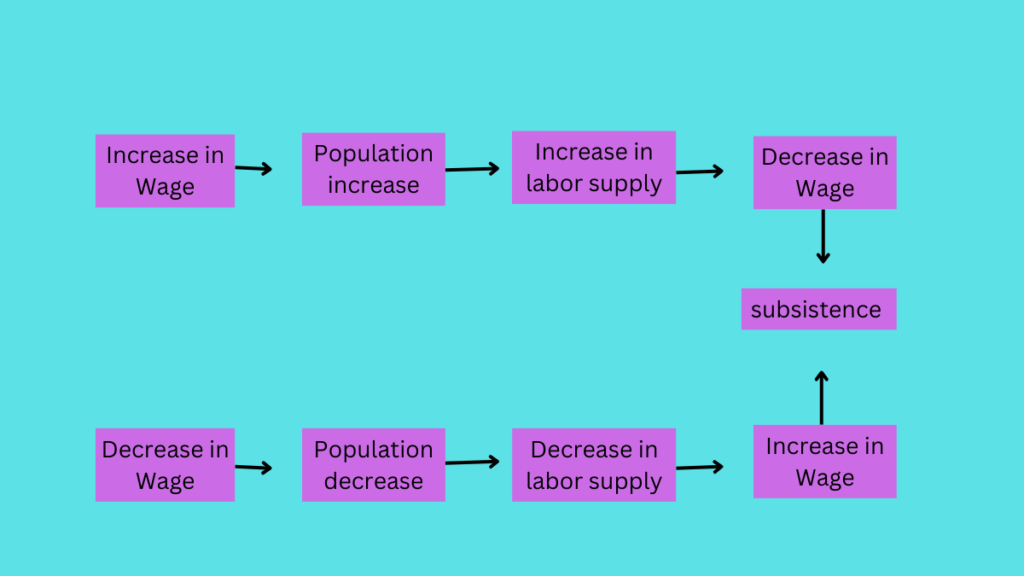Wages are the remuneration or reward for labor. In economics, the price paid to labor for its contribution to the production process is called wages. Labor is an important and mobile factor of production. If there is no labor, all other factors, be it land or capital, will remain idle. Thus, Karl Marx termed labor as the ‘creator of all value’. However, labor alone cannot be produced as most of the production is the result of joint efforts of different factors of production. Therefore, the share of the produce paid to labor for its production activity is called a wage.
Benham: A wage may be defined as the sum of money paid under contract by an employer to workers for services rendered.
Money (Nominal) and Real wage
Wages are the monetary payment for human exertions and net benefits enjoyed by working at a certain work. There are two concepts wage money and real wages.
Money wages or Nominal Wages
A nominal wage is the money paid to a worker to reward his work. By nominal wages, we mean the money paid to a laborer as a reward for his work. Wages may be paid daily, weekly, or monthly. Nominal wages are wages paid or received in terms of money. Wages paid and received in terms of money are called cash wages. It includes monetary payments only. This is also called nominal or money wage. Nowadays wages are generally paid as money wages almost in all countries of the world.
Real wages
By real wages, we understand the satisfaction that a laborer gets from spending his money wages in the form of necessaries, comfort, and luxuries. The amount can purchase goods and services and extra facilities provided by the employer is known as real wage. Real wages means the purchasing power of money wages in terms of goods and services consumed by the wage-earners plus other facilities provided by the employer, free of cost. The other facilities include different allowances, insurance, transportation facilities, health care, accommodations, etc. Thus except for the goods and services that can be purchased by money wages, all facilities, concessions, and advantages received by the laborers are also included in the computation of real wages.
Thomas, Real wages refer to the net advantages of worker remuneration i.e., the amount of the necessary comforts and luxuries of life which the workers can command in return for his services.
Seligman, Real wages are actual commodities that money wages can buy.
Adam Smith, The real wages of labor may be said to consist in the quantity of the necessaries and conveniences that are given for it, its nominal wage is the quantity of money. The laborer is rich or poor, is well or ill-rewarded in proportion to the real no the nominal wages of his labor.
The real wage is the amount of purchasing power received by a worker through his money wage. Thus, real wage can be measured as under.
Real wage = Nominal Wage / Price Level
Subsistence Theory of Wage
According to this theory, the wages of a worker in the long run are determined at the level of wages which is just sufficient to meet the necessaries of life. This level is called the subsistence level. The classical economists called it the neutral level of wages.
Assumptions
This theory is based on the following assumptions:
- Population increases at a faster rate.
- Food production is subject to the law of diminishing returns.
- Equality in the cost of labor productivity and level of subsistence wage.
- It is the long-run theory of wages.
- here is no existence of a labor union.
Analysis
The word subsistence literally means supporting oneself, especially at a minimal level. So the theory is based on the idea that wages would be equal to the amount just sufficient for subsistence. According to this theory, wages are determined by the cost of production of labor or subsistence level. The wages determined will remain fixed.
If actual wages are higher the subsistence level, then the population will increase leading to an increase in labor supply and lower wages. If on the other hand, the actual wages fall below the subsistence level, the population will decrease resulting in a decline in labor supply and a rise in wages. Since there is a tendency for the wages to remain fixed at the subsistence level. It is also clearly exhibited in the following figure.

Criticism
The following are the main defects of the subsistence theory of wages:
- One-sided theory: This theory examines wage determination from the side of supply and ignores the demand side.
- Pessimistic: The subsistence theory of wages is highly pessimistic for the working class. It presents a dark picture of the future of the society.
- Long period: This theory is based on the assumption of the long run. It does not explain the determination of wages at a particular period.
- No historical evidence: This theory has been criticized because it has not been correct in conclusions. The case of Western countries is different from the conclusions of this theory.
- No difference in wages: This theory explains that all workers get equal wages. As we know, workers differ in their productivity, so the difference in their wages is natural.
- Ignorance of trade unions: This theory ignores the role of trade unions. But in the present age, unions are playing a significant role in determining wages.
Wages Fund Theory
According to Prof. J.S. Mill, the employers set apart a certain amount of capital to pay wages for laborers. This is fixed and constant. This is called a wages fund. Wage is determined by the amount of wages funded and the total number of laborers.
According to Adam Smith, the demand for labor and the rate of wages depend on the size of the wage fund. Accordingly, if the wages fund is large, wages would be high, and vice versa. Under this theory, a fixed proportion of the capital of a country was set apart for payment as wages of laborers. This proportion is called the wages fund.
Thus according to J.S. Mill, wages at any moment were determined by the amount of money in the wages fund and the total number of workers in the country. If the fund remained constant and the supply of labor increased wages would fail, and vice versa. It is implied that if wages are forced up, capital will leave the country.
As per the wage fund theory, the wage level depends on the quantity of the wage fund and the number of people who are employed. Wage fund refers to the amount of capital that an employer keeps for paying wages to labor. The level of wages can be determined with the help of the following formula:
Level of Wages = Wage fund / Number of employees
Assumptions
- The wage fund is fixed and created by past saving
- Wage is equally paid out of the wage fund
- The units of labor are homogeneous
- There is no labor union
- The wage level is flexible with the change in number of workers employed
- Money is taken as a medium of exchange
- The level of wages depends on the size of the population
- There is positive relationship between wages fund and level of wages
Analysis
The wages fund theory is clearly illustrated in the schedule and diagram as follows:
| Wage Fund (Rs.) | Number of Workers | Level of Wages = Wage fund/Number of workers |
|---|---|---|
| 500000 | 100 | 5000 |
| 500000 | 200 | 2500 |
| 500000 | 400 | 1250 |
| 500000 | 500 | 1000 |
The above table shows the fixed wages find of Rs. 500000. Colum 2 shows the number of worker employed in increasing trend. Level of wages, which is computed by dividing wages fund to number of employees, is decreases with the increasing number of workers.

Criticisms
The following are the main defects of the wages fund theory:
- Ignores efficiency of labor: The theory ignores the efficiency of labor. It may be that the theory assumes the homogeneity of labor. It assumes that all laborers are equally efficient.
- Wage and employment: According to this theory, a reduction in the wage rate will increase employment. However, according to Keynes, wages are not only part of the production cost but also the score of demand. Reduction in wage fate will reduce the cost of production on one side and another side resulting in a decrease in demand. It increases unemployment.
- Wage fund: The theory does not tell us about the sources of the wage fund and the method by which it is estimated. It simply tells us that the wage can be ascertained by dividing the wages fund by the number of workers.
- Ignores trade union: The theory ignores the importance of trade unions. It is unrealistic that the trade unions are powerless to increase the wage. In modern period, trade unions play an important role in wage determination.
- Derived demand for labor: The factor demand is a derived demand. Factors of production are demanded because goods and services they can produce are demanded. It has no relation to wage funds. In fact, this theory assumes that demand for labor depends on wages fund.
